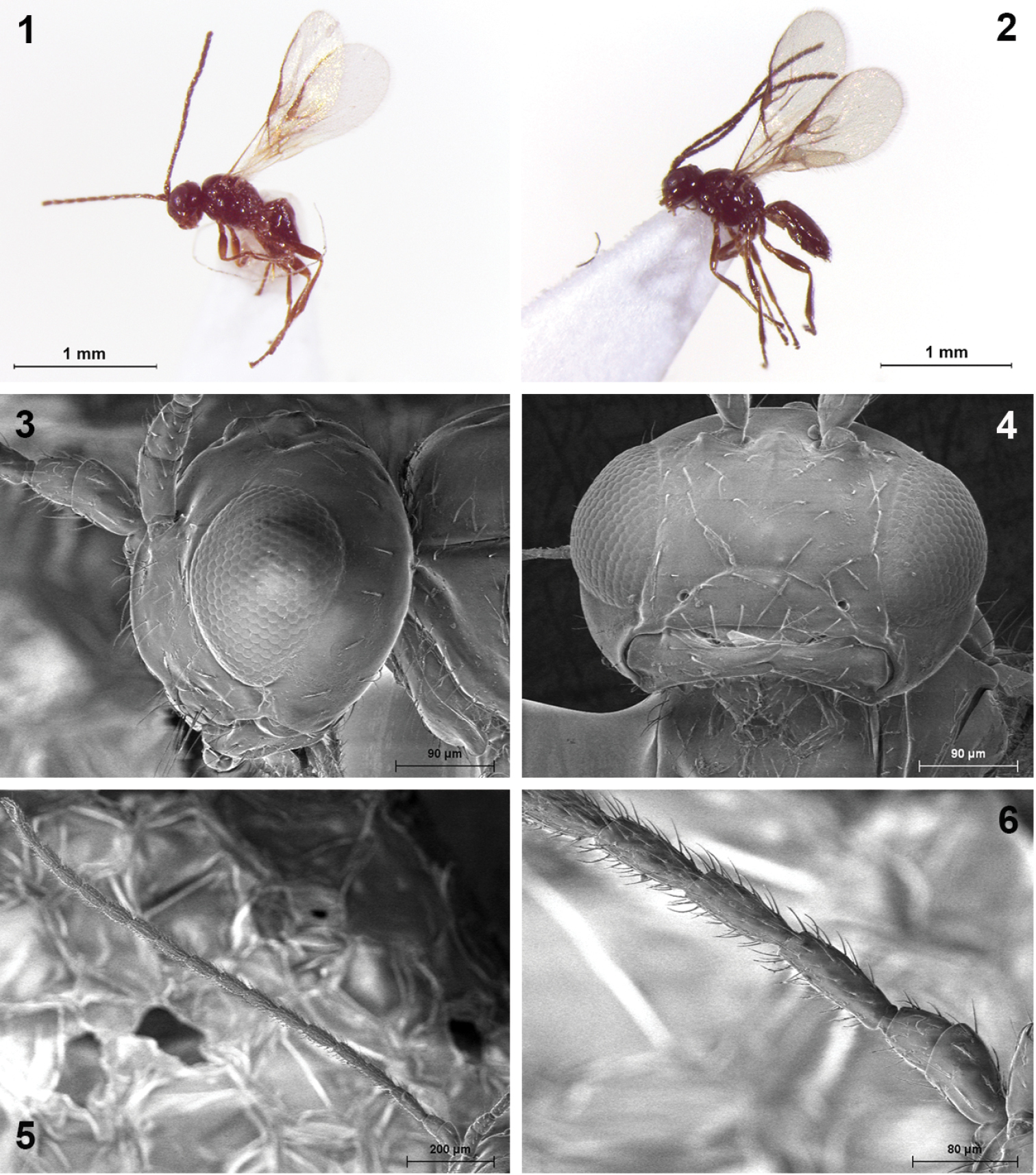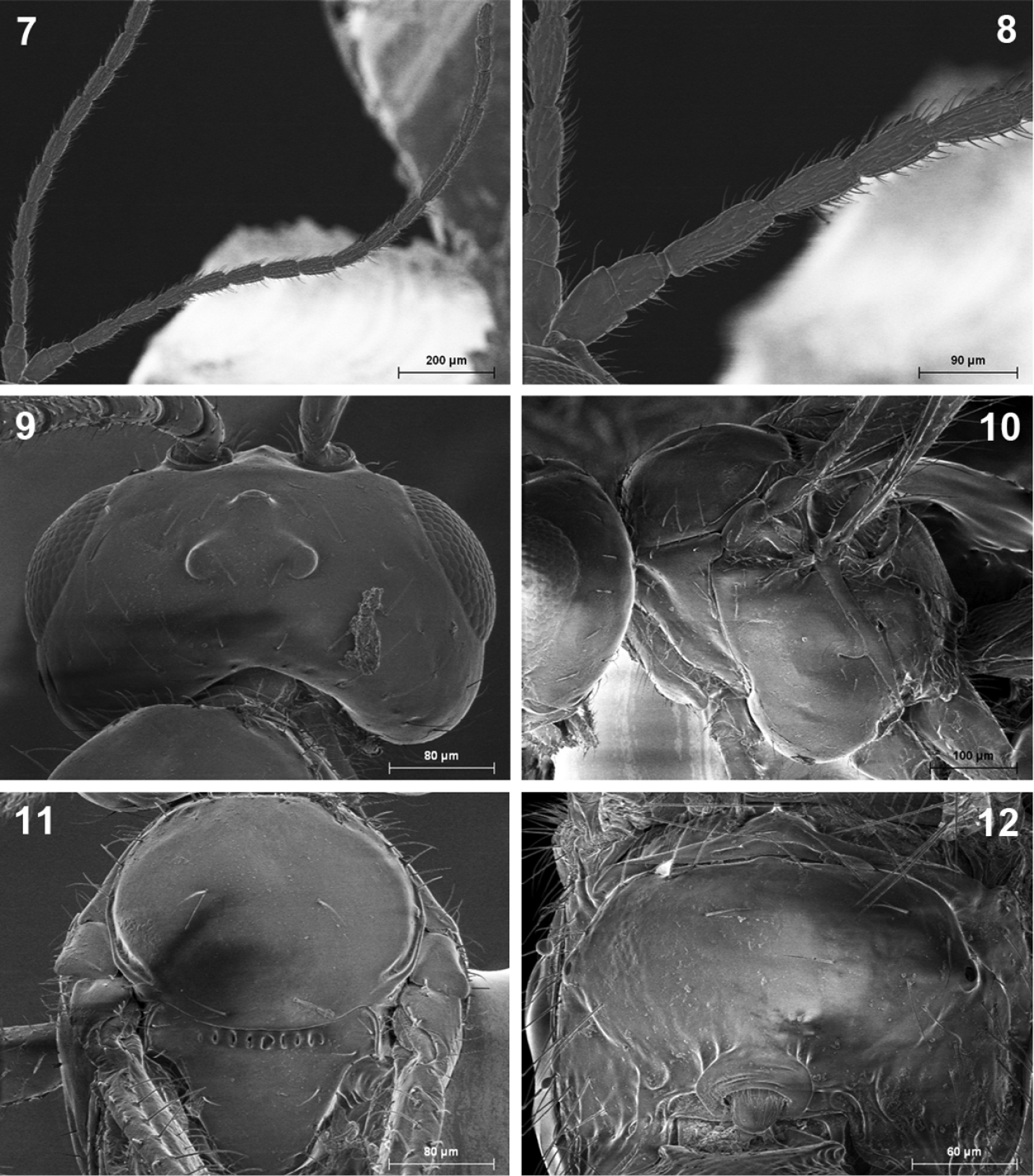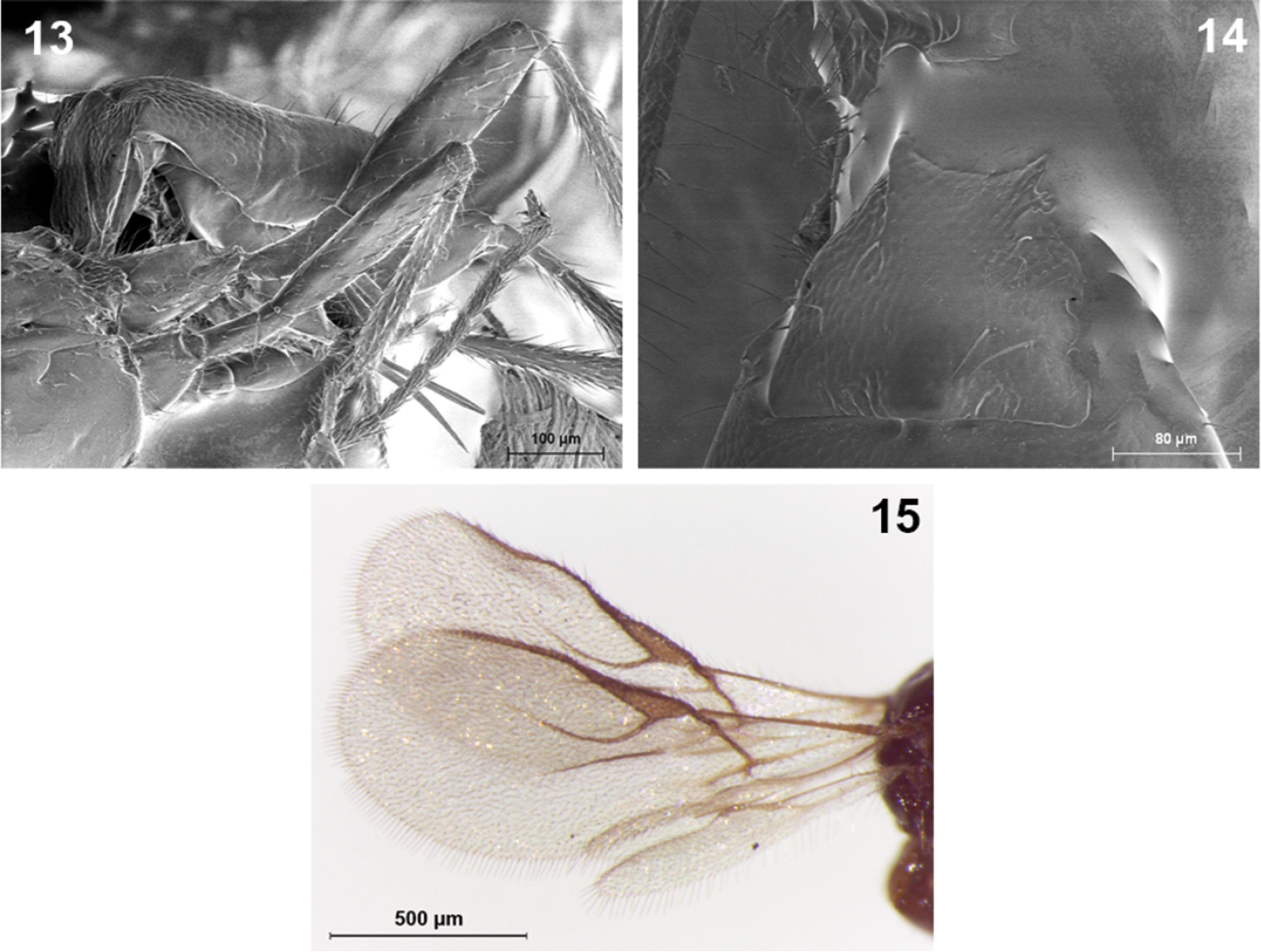






(C) 2014 Francisco Javier Peris-Felipo. This is an open access article distributed under the terms of the Creative Commons Attribution License (CC BY 4.0), which permits unrestricted use, distribution, and reproduction in any medium, provided the original author and source are credited.
For reference, use of the paginated PDF or printed version of this article is recommended.
Citation: Peris-Felipo FJ, Rahmani Z, Belokobylskij SA, Rakhshani E (2014) Genus Indiopius Fischer, 1966 (Hymenoptera, Braconidae, Opiinae) in Iran with a key to the world species. ZooKeys 368: 37–44. doi: 10.3897/zookeys.368.6658
The Iranian species belonging to the genus Indiopius Fischer are reviewed. A description of the first recorded female of I. cretensis Fischer, 1966 is provided. A key to the world species of the genus Indiopius is given.
Braconidae, Opiinae, Indiopius, new records, key, Iran
The subfamily Opiinae contains approximately 2, 000 catalogued species worldwide (
The genus Indiopius Fischer, 1966 is a small and rarely collected taxon, with only eight known species, despite its wide distribution throughout the Afrotropical, Oriental and Palaearctic regions (
Our investigation of the braconid parasitoid wasps of the subfamily Opiinae in Iran allowed the discovery of the genus Indiopius Fischer; one species is described from Iran for the first time. The description of the female of Indiopius cretensis, only the male was known until now, and a key for identification of the world species of Indiopius are included in this paper.
Specimens were collected using standard sweeping nets on semi-aquatic plants within a protected landscape in the Sistan area (31°02'N, 61°32'E, 485 m A.S.L). This small area is artificially irrigated to protect the endemic flora and fauna from the unfavorable dry climates of the recent decade.
A field emission gun environmental scanning electron microscope (Hitachi S-4100) at 2 kV was used for high-resolution imaging without gold coating.
For the terminology of the morphological features and sculpture, measurements and wing venation nomenclature, see van
http://species-id.net/wiki/Indiopius_cretensis
Figures 1–151 ♂ (holotype), Greece, Crete, Biro, Canea, 1906/11 (Hungarian Natural History Museum, Budapest); 2 ♀ and 4 ♂, Iran, Zabol (31°02'28"N, 61°32'02"E, 482 m A.S.L.), 26.iv.2013, sweeping on Cyperus rotundus (Z. Rahmani leg.) (ENV, ZISP); 7 ♀ and 20 ♂, same locality, 22–24, 26 and 27.iv.2013 (Z. Rahmani leg.) (FAUOZ).
This species resembles Indiopius fischeri Samiuddin et Ahmad from India and Indiopius turcmenicus Tobias from Turkmenistan. Indiopius cretensis differs from Indiopius fischeri in has the maxillary palpi as long as head height (0.5 times in Indiopius fischeri), the first flagellar segment of female 2.55–2.65 times as long as its width (2.1 times in Indiopius fischeri), and the middle flagellar segments of female 2.25–2.65 times as long as their width (1.5 times in Indiopius fischeri). Also, Indiopius cretensis differs from Indiopius turcmenicus in having the first flagellar segment of female 2.55–2.65 times as long as its width (3.0 times in Indiopius turcmenicus), the middle flagellar segments of female 2.25–2.65 times as long as their width (2.0 times in Indiopius turcmenicus), the first metasomal tergite 1.0–1.1 times as long as its apical width (0.8 times in Indiopius turcmenicus), and vein 1cu-a postfurcal (interstitial in Indiopius turcmenicus).
Female (first record). Body length 1.0–1.1 mm; fore wing length 1.4–1.5 mm.
Head. In dorsal view, 2.0 times as wide as median length, 1.4 times as wide as mesoscutum, smooth, with rounded temples behind eyes. Eye in lateral view 1.35 times as high as wide and twice as wide as temple in middle. POL 2.6 times OD; OOL 3.45 times OD. Face 1.25 times as wide as high; inner margins of eyes subparallel. Clypeus 3.35 times as wide as high, slightly curved ventrally. Mandible narrow, weakly and evenly widened towards base; upper tooth longer than lower tooth. Maxillary palpi as long as head height. Antenna thick, 18-segmented. Scape 1.40–1.45 times as long as maximum width, about twice as long as pedicel. First flagellar segment 2.55–2.65 times as long as its apical width, 1.15–1.20 times as long as second segment; second segment 2.6–2.7 times as long as its maximum width. Third to ninth flagellar segments 2.55–2.65 times and tenth to sixteenth segments 2.25–2.30 times as long as their maximum width.
Mesosoma. In lateral view, 1.05 times as long as high. Mesoscutum 0.75–0.80 times as long as its maximum width. Notauli mainly absent, finely developed on vertical anterior part. Mesoscutal pit absent. Prescutellar depression with numerous carinae. Precoxal suture present, very shallow, not reaching anterior and posterior margins of mesopleuron. Posterior mesopleural furrow smooth. Propodeum completely smooth. Propodeal spiracles relatively small.
Legs. Hind femur 3.60–3.65 times as long as its maximum width. Hind tibia weakly widened towards apex, about 10.0 times as long as its maximum subapical width, 1.1 times as long as hind tarsus. First segment of hind tarsus 1.3 times as long as second segment.
Wings. Length of fore wing 2.5 times its maximum width. Pterostigma almost triangular. Vein 1-R1 not reaching wing apex and as long as pterostigma. Veins r, 3-SR and SR1 not differentiated; 1-M straight; cu-a postfurcal, 1-CU1 widened. First subdiscal cell open. CU1b absent. M+CU1 only apically sclerotized. Hind wing 6.5 times as long as its maximum width; vein cu-a absent.
Metasoma. Distinctly depressed dorso-ventrally, apical segments rather distinctly protruding behind third tergite. First tergite weakly widened towards apex, 1.1 times as long as its apical width, finely rugose but basally smooth. Second tergite largely finely granulate. Third and following tergites smooth. Ovipositor 1.05 times as long as first tergite, 0.65 times as long as hind femur.
Colour. Body and legs uniformly brown to dark brown, second tergite yellowish brown. Wings hyaline. Pterostigma brown.
Male. Body length 1.4–1.5 mm; fore wing length 1.5 mm. First flagellar segment 2.7–2.8 times and second segment 2.5 times as long as their width accordingly. Third to sixteenth flagellar segments 2.20–2.75 times as long as their width. Otherwise similar to female.
Indiopius cretensis Fischer (1, 3–6 female 2 male). 1, 2 Habitus, lateral view 3 Head, lateral view 4 Face in front view, mandible and maxillary palpi 5 Antenna 6 Basal segments of antenna.
Indiopius cretensis Fischer (7, 8 male 9–12 female). 7 Antenna 8 Basal segments of antenna 9 Head, dorsal view 10 Mesosoma, lateral view 11 Mesoscutum 12 Propodeum.
Indiopius cretensis Fischer (female). 13 Hind and middle legs, metasoma and ovipositor, lateral view 14 First metasomal tergite 15 Fore and hind wings.
Cape Verde Islands, Greece, Turkey, and Iran (new record).
| 1 | Precoxal suture long, reaching anterior or anterior and posterior margins of mesopleuron | 2 |
| – | Precoxal suture short, not reaching anterior and posterior margins of mesopleuron | 3 |
| 2(1) | Maxillary palpi 0.6 times as long as head height. Hind femur 3.3 times as long as its maximum width. First flagellar segment 2.2 times as long as its maximum width. Head in dorsal view 1.75 times as wide as median length. Antenna 19–segmented. Body length 1.3 mm. China | Indiopius chenae van Achterberg & Li (♀) |
| – | Maxillary palpi as long as head height. Hind femur 4.0 times as long as its maximum width. First flagellar segment 2.5 times as long as its maximum width. Head in dorsal view 2.0 times as wide as median length. Antenna 19–segmented. Body length 1.4 mm. Turkey, Vietnam | Indiopius saigonensis Fischer (♀) |
| 3(1) | Hind femur wide, 3.60–3.65 times as long as its maximum width | 4 |
| – | Hind femur narrow, 4.0–4.5 times as long as its maximum width | 6 |
| 4(3) | First flagellar segment 2.1 times as long as its maximum width. Middle flagellar segments 1.5 times as long as their width. Maxillary palpi 0.5 times as long as head height. – Vein 1 cu-a clearly postfurcal. Antennae 18–segmented. Body length 1.3 mm. India | Indiopius fischeri Samiuddin & Ahmad (♀♂) |
| – | First flagellar segment 2.65–3.00 times as long as its maximum width. Middle flagellar segments 2.00–2.55 times as long as their width. Maxillary palpi as long as head height | 5 |
| 5(4) | First flagellar segment 2.65 times as long as its maximum width. Middle flagellar segments 2.25–2.55 times as long as their width. First metasomal tergite 1.0–1.1 times as long as its apical width. Vein 1 cu-a postfurcal. Antennae 18–20–segmented. Body length 1.0–1.5 mm. Cape Verde Islands, Greece, Turkey, Iran | Indiopius cretensis Fischer (♀♂) |
| – | First flagellar segment 3.0 times as long as its maximum width. Middle flagellar segments about 2.0 times as long as their width. First metasomal tergite 0.8 times as long as its apical width. Vein 1 cu-a interstitial. Antennae more than 14–segmented (missing apically). Body length 1.3 mm. Turkmenistan | Indiopius turcmenicus Tobias (♀♂) |
| 6(3) | First flagellar segment 2.5 times as long as its width. Middle flagellar segments about 1.5 times as long as their width. – Maxillary palpi as long as head height. Hind femur 4.5 times as long as its maximum width. Vein 1 cu-a almost interstitial. Antennae 19–segmented. Body length 1.7 mm. India | Indiopius humillimus Fischer (♀) |
| – | First flagellar segment 3.0 times as long as its width. Middle flagellar segments about twice as long as their width | 7 |
| 7(6) | Maxillary palpi 0.7 times as long as head height. First metasomal tergite 1.2 times as long as its apical width. Head in dorsal view 1.7 times as wide as its median length. Antenna 18–19–segmented. Body length 1.3–1.4 mm. China | Indiopius alucitacius Weng & Chen (♀) |
| – | Maxillary palpi as long as head height. First metasomal tergite as long as its apical width. Head in dorsal view 1.9 times as wide as its median length. Antenna 18–segmented. Body length 1.1 mm. Turkey | Indiopius yilmazae Fischer & Beyarslan (♀) |


